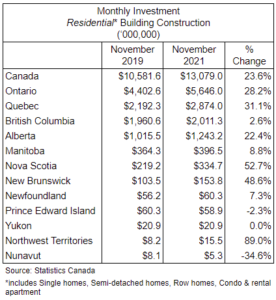Continued low-interest rates by the Bank of Canada, escalating housing prices in all major metropolitan areas, and continued increasing demand for housing has made perfect conditions to drive investment in building construction.
Since the depths of the great shutdown due to COVID-19 (March 2020), investment into building construction has been on a sharp return. Current levels now exceed the pre-pandemic levels of November 2019.
The greatest gains in monthly investment into residential building construction has been in the Northwest Territories (+89%), Nova Scotia (+52.7%), and New Brunswick (+48.6%), while provinces that continue to be worse off than November 2019 are Nunavut (-34.8%) and Prince Edward Island (-2.3%).

While residential construction is trending higher for most provinces, non-residential building construction appears to be not as robust. Some provinces are experiencing higher monthly investment in non-residential construction than pre-pandemic, but most are still well below their pre-pandemic levels. The provinces that are experiencing higher than pre-pandemic monthly investment in non-residential building construction are Prince Edward Island (+32.3%), the Northwest Territories (+26.2%), Ontario (+9.3%), Quebec (+6.8%), and Newfoundland & Labrador (+4.5%), while the rest of the provinces/territories continue to be worse off than pre-pandemic.

Nunavut is the worst off of all provinces/territories for residential and non-residential building construction. The territory was facing a pre-pandemic housing shortage and things appear to have worsened. The Nunavut Housing Corporation has scaled back construction of new residences due to the escalating costs of construction, claiming the cost of lumber has increased exponentially and that the project will not go ahead until costs come down. Unfortunately, it is unlikely that high prices of construction materials will come down any time soon.
Things appear to be quite different to the west of the Parker line.
The National Housing Co-investment Fund’s $60 million northern carve-out has been set aside by the Government of Canada to address housing needs and challenges in the Northwest Territories. This critical funding is currently being rolled out to offset high construction costs caused by the unique building challenges faced in the north.
As a part of The National Housing Strategy’s (NHS), a 10-year, $72+ billion plan to create a new generation of housing in Canada giving more Canadians a place to call home and where all Canadians have access to affordable housing that meets their needs, the strategy lists the priority areas as the three territories. It appears that the Northwest Territories is thriving while their neighbours to the east in Nunavut are worse off.
The federal Minister of Housing and Diversity and Inclusion recently declared, “Our government is doing its part to ensure that every Canadian has a safe and affordable place to call home.”
Perhaps the Minister may wish to look a little closer at the numbers across all the “areas of priority.”
Gerard Lucyshyn is an economist and an economics lecturer in the Department of Economics, Justice and Policy Studies at Mount Royal University in Calgary, Alberta. He has also served as a business and economic consultant to a variety of industries. Gerard has authored a number of articles and research papers on municipal, provincial, federal and international economic and policy issues.



